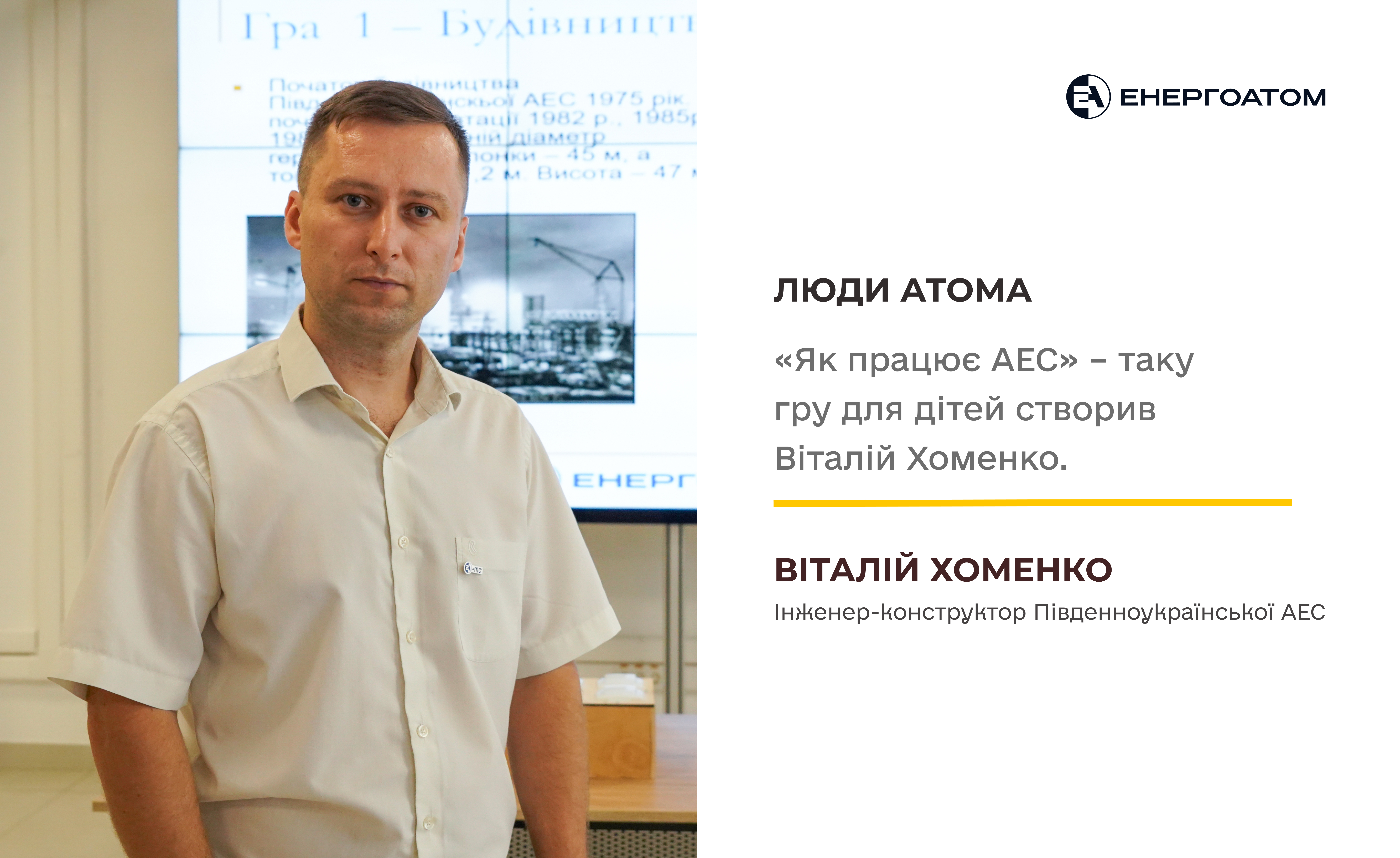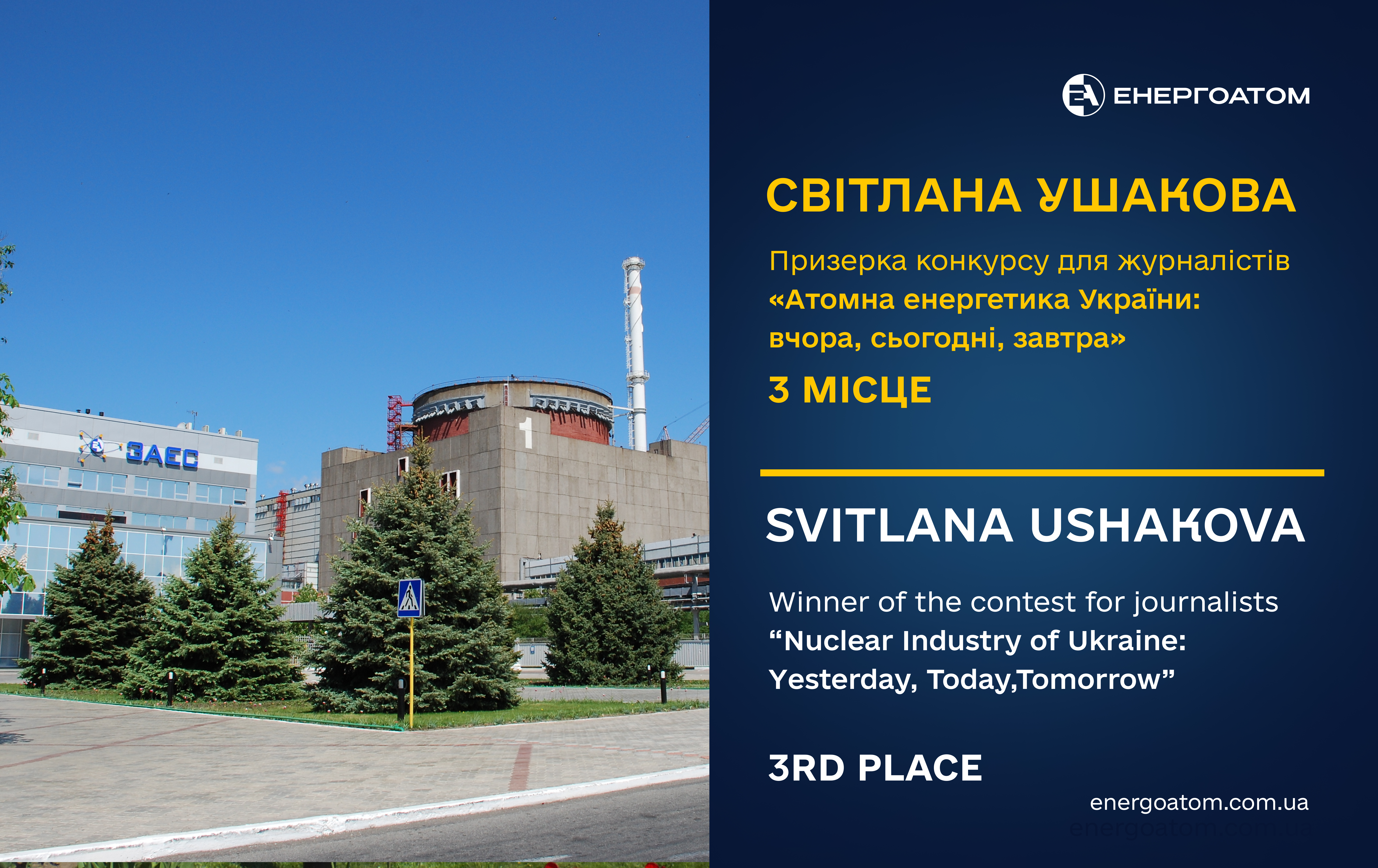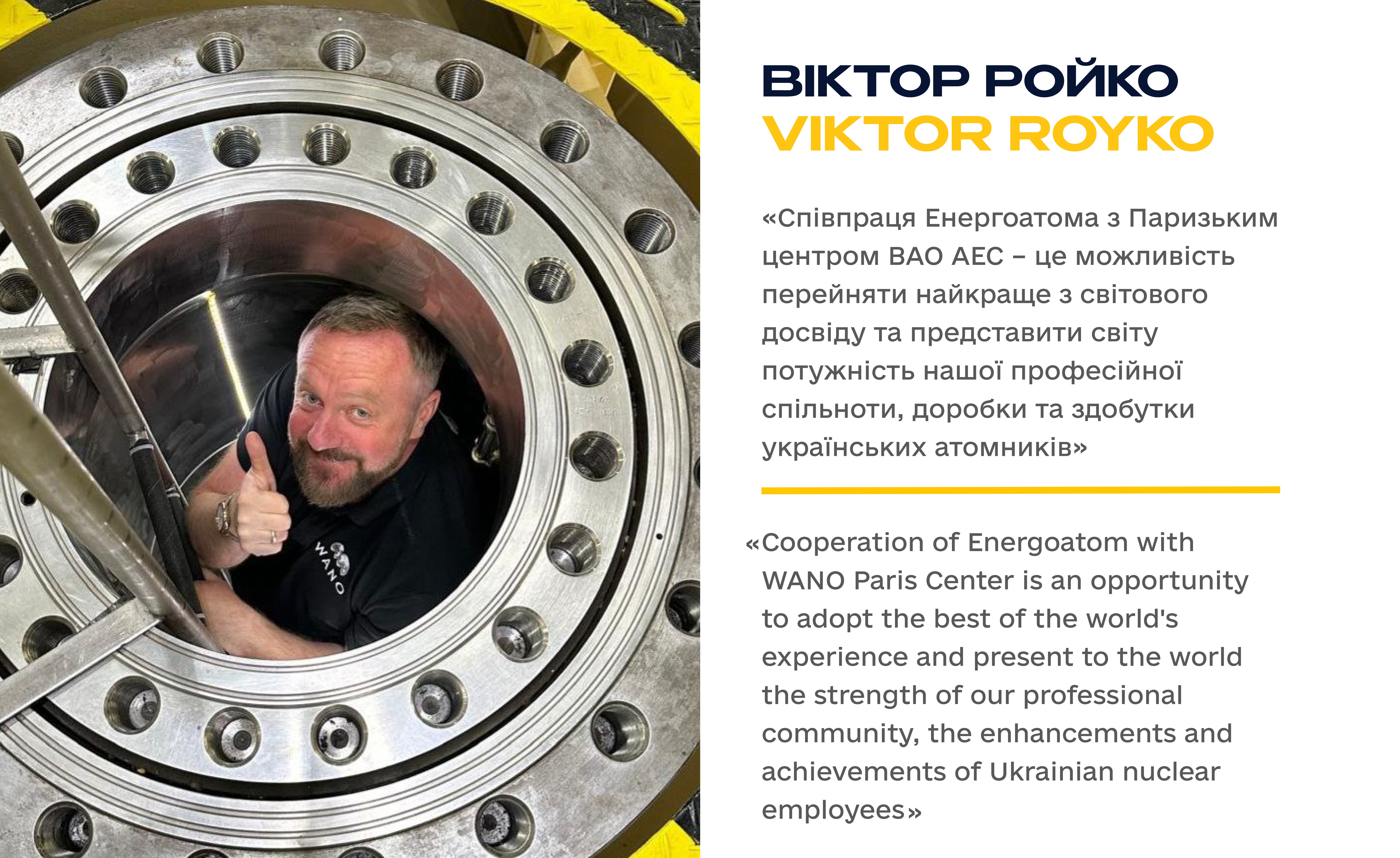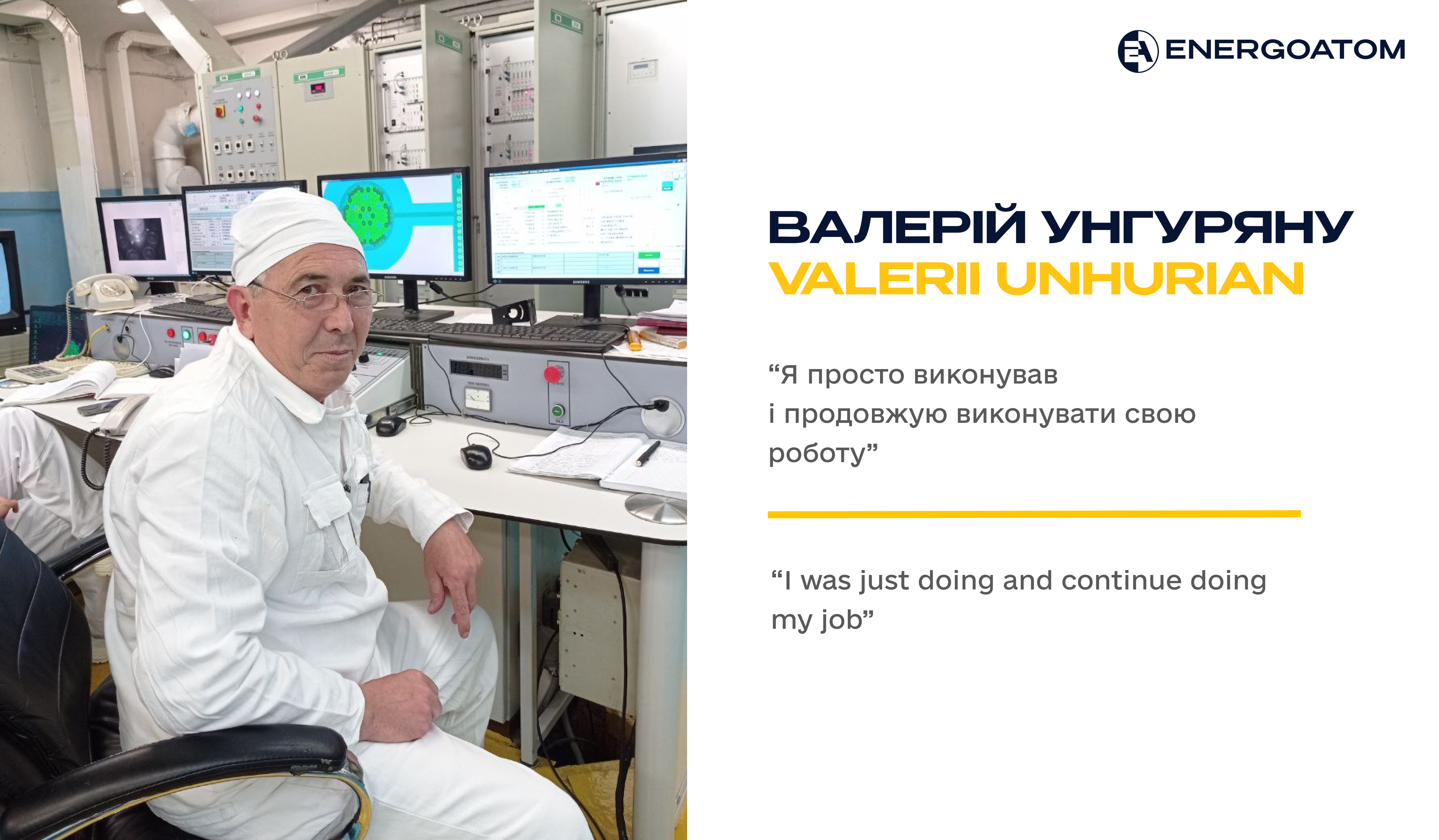20.09.2024
Game to get acquainted with NPPs based on Vitalii Khomenko's idea

A design engineer from South Ukraine NPP attracts schoolchildren's interest in nuclear energy in a very creative way
Building blocks, loading a reactor, starting a turbine – all this can be tried by joining a game invented and created by Vitalii Khomenko, a design engineer at South Ukrainian NPP. The educational game project for schoolchildren has a name “How a Nuclear Power Plant Operates” and has already gained many young fans. And not only in Yuzhnoukrainsk, where it all started but also in Kharkiv and recently in the capital.
The idea is to explain to children the complex technological processes that take place at a nuclear power plant through a game, allowing them to recreate them with their own hands – on improvised models of equipment – and sparking interest amongst schoolchildren so that they would later consider the prospect of becoming a nuclear professional as one of their priorities.
Since November 2023, about 180 children have taken part in such games in a competitive format. Mostly seventh-graders, because the project was originally focused on them. The NPP game was also popular with 8th and 10th graders.
Recently, the game for eighth-graders was held for the first time in Kyiv, in one of Energoatom's offices, with the support of NNEGC and the Ukrainian Nuclear Society (UkrNS), whose activist is Vitalii Khomenko. Such support is a constant feature of this project, significantly enhancing its career guidance component.
Vitalii Khomenko has been working at South Ukrainian NPP for 15 years, the last seven in the design-engineering service. He is the initiator of other events for children as well. He has also repeatedly been a prizewinner in the SUNPP competition for scientific and technical reports and has presented his work at Energoatom and UkrNS competitions.
- Vitalii, what is the history of this project?
- Both Energoatom and UkrNS pay a lot of attention to career guidance for schoolchildren and have several projects. It is always important to arouse the interest of children and bring them closer to nuclear energy. Therefore, I came up with the idea of such games – with exercises that reflect real processes at a nuclear power plant. I thought it would be interesting for children to learn about the operation of a nuclear power plant in this way. I focused on the team-building format so that it would be a team competition with the ability to think and act as a whole. The idea found support, so we started implementing it with our colleagues, UkrNS activists.
The game for seventh-graders consists of 5 tasks: ‘NPP construction‘, ‘Pipeline installation’, ‘Nuclear fuel loading’, ‘Turn the turbine’, ‘Connection to the power system’. We first introduce the children to how a nuclear power plant is built and operates, and how electricity enters the grid. Then we do practical tasks for quick reaction, when, for example, conditional fuel assemblies should be loaded into a reactor model. Finally, there are consolidation tests. The game is dynamic, usually, 5 teams, each consisting of 4 players, manage to complete all the exercises in an hour.
- How long did it take to prepare?
- It took about a year from concept development to the first competition. In particular, it took three months to make the equipment for the seventh-grade competition.
- It is known that you developed the tasks and created the equipment models yourself. Tell us about it.
- I identified the topics and developed the exercises and layout designs. I had to think about it because the real NPP equipment is complex, but its models had to be adapted to the game and understandable for children. I came up with interpretations and then made them with my own hands. The models are made of different materials; plywood is quite convenient, especially for the frame. I draw a drawing, order a laser cut of plywood, and then assemble it. For details, I use pipes, switches, wooden blocks, etc. I do this in my spare time. That's why I plan everything in advance. Now we are making equipment for the competition for eighth graders.
- Will it be a different game in terms of content?
- The form is the same, but the content is different, more complex, and focused on the 8th grade. The name of the game is “NPP. What? How? Why?” We are planning to launch it this fall.
- Have your expectations been met? Have you seen the children's response?
- Yes! We saw a lot of interest. The children are active, emotional, smiling, and eager to win. Moreover, what emotions when we announce the prizes! Therefore, everything came true, and we want to improve.
- What topic is the most exciting for the participants of the game?
- Seventh-graders really like “Loading Nuclear Fuel”. They perform the actions very diligently, probably realizing that there is no room for error.
- Do you plan to work with children from 7th grade to graduation?
- This is the project's strategy. We start with 7th grade when students begin to study physics. When they move to the 8th grade, we prepare a new game for them. The same goes for 9th and higher grades. At the same time, we are working on games for the next seventh graders. We have released a “Steps Accumulator” where they enter their points, honors, etc. If upon graduation the most active participants of our educational activities choose to continue their studies in nuclear specialties, the head of UkrNS in Yuzhnoukrainsk will recommend the SUNPP management to conclude a trilateral agreement with the owner of the “Steps Accumulator” for studying at an industry-specific university.
- So you expect to see the final result when the current seventh-graders become graduates?
- This project is educational and career guidance. In particular, we aim to increase the number of school graduates willing to study in the nuclear field.
- What motivates you and your team of like-minded people?
- Children are fascinated by this, so we work for a reason. I believe that delivering information in this way is effective, and participants will remember all the processes. This is how a positive opinion about nuclear energy is formed, that working at a nuclear power plant is not only responsible but also interesting.
- Is this not the only project of this kind that you have implemented?
- I also initiated a competition for young designers called “I am an Engineer” as part of the joint project of SUNPP and UkrNS “SUNPP Nuclear Academy”. The goal is to develop children's engineering thinking. For example, participants are asked to make protective devices for a chicken egg that must remain intact after a “flight” from a 9-meter height. Significantly, only two of the 16 eggs broke. By the way, this exercise is from my childhood. I was fond of Lego, stacked different objects, and dropped them from a height to determine the most stable construction.
- Who helps you realize your ideas?
- A lot of colleagues. But the most active one is Yevhen Dorol, a leading operation engineer at SUNPP Reactor Shop No. 2.
- What is your personal history as a nuclear professional?
- I am originally from the Kirovohrad region. I studied at the Sevastopol National University of Nuclear Energy and Industry, specializing in Power Plants. Since September 2009, I have been working at SUNPP, starting as an electrician in the electrical shop. However, I wanted to get into the design-engineering service, and in 2017, I won a competition for the position of design engineer. I am still here today.
- What attracts you to the work of a designer?
- Designing has been my thing since childhood. I would even say that my path to the design department of a nuclear power plant began in childhood, with Lego. Design work is interesting because it often requires quick and correct decisions. I make working drawings of parts and assemblies for thermal and mechanical and other NPP equipment and develop projects for repair or reconstruction. The equipment is diverse, so I am constantly learning. I am inspired by the fact that you always feel fully supported by the team. I am proud of my colleagues, they are high-class professionals.
- Do you have your own developments? After all, you are a frequent participant in scientific report competitions at SUNPP and the Company.
- I have participated in scientific report competitions at SUNPP three times and once at NNEGC. For the first time at the plant, in 2021, we presented a joint project with Reactor Shop -2 employee Artem Shyshkanov – a model of a robot for operations on steam generator collectors and then took 3rd place. Then I independently developed an electric gripper for removing foreign objects from hard-to-reach places of NPP equipment and prepared a report that took 2nd place in the plant competition. The third entry, on the removal of silt deposits from the sedimentation tank, won 1st place at the SUNPP competition and 4th place at the Company level.
- In your opinion, why is it important, especially now, to form a positive image of the nuclear industry in society? This is what you are doing with the younger generation.
- I believe that people who are far from nuclear power lack awareness. Therefore, it is important to form an understanding of the strategic importance of the nuclear industry, especially now, when it is electricity from NPPs that powers the entire country. It is also important to explain that it is safe, environmentally friendly energy. Therefore, the work aimed at children and young people, which is carried out by Energoatom together with UkrNS, is extremely important. It spreads and strengthens confidence not only among young people but also in society as a whole in the peaceful use of nuclear energy.
MORE NEWS

Svitlana Ushakova is a former employee of Zaporizhzhia NPP who spent more than a year in occupied Energodar. Six stories of Energodar residents who believe they will return to ZNPP
16.08.2024

For Viktor Royko, work at WANO Paris Center means personal development and new perspectives
26.07.2024

Oksana Kazymyrska: the Rivne NPP, international projects, WANO Paris Center
28.06.2024

The story of Valerii Unhurian, operator of the refueling machine of the South Ukraine NPP Unit 3
31.05.2024


 UA
UA





